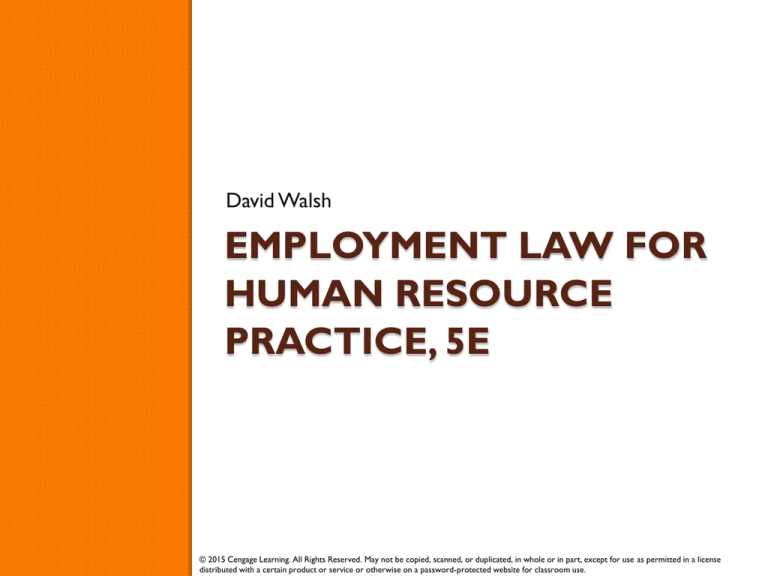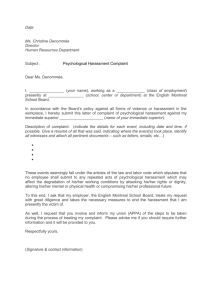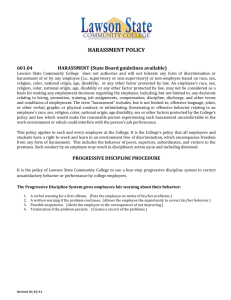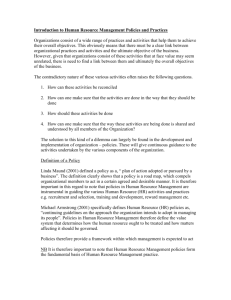
David Walsh
EMPLOYMENT LAW FOR
HUMAN RESOURCE
PRACTICE, 5E
© 2015 Cengage Learning. All Rights Reserved. May not be copied, scanned, or duplicated, in whole or in part, except for use as permitted in a license
distributed with a certain product or service or otherwise on a password-protected website for classroom use.
Harassment
Chapter 9
© 2015 Cengage Learning. All Rights Reserved. May not be copied, scanned, or duplicated, in whole or in part, except for use as permitted in a license distributed with a certain product or
service or otherwise on a password-protected website for classroom use.
Chapter Outline
Harassment as a Form of Discrimination
Recognizing Harassment
Liability for Harassment
Eliminating Harassment
© 2015 Cengage Learning. All Rights Reserved. May not be copied, scanned, or duplicated, in whole or in part, except for use as permitted in a license distributed with a certain product or
service or otherwise on a password-protected website for classroom use.
Harassment as a Form of
Discrimination (1 of 2)
Harassment is a major obstacle to
realizing equal employment opportunity
It is not limited to sexual harassment,
though that is the most common type
Harassment may be based on national
origin, age, disability or religious beliefs
The liability of the employer is the same no
matter the type of harassment
◦ Workplace bullying may not be legally
actionable harassment
© 2015 Cengage Learning. All Rights Reserved. May not be copied, scanned, or duplicated, in whole or in part, except for use as permitted in a license distributed with a certain product or
service or otherwise on a password-protected website for classroom use.
Harassment as a Form of
Discrimination (2 of 2)
© 2015 Cengage Learning. All Rights Reserved. May not be copied, scanned, or duplicated, in whole or in part, except for use as permitted in a license distributed with a certain product or
service or otherwise on a password-protected website for classroom use.
Harassment as…Discrimination Because of Sex (1 of 2)
Legal challenges to harassment come under
anti-discrimination laws, and not under any
law specifically banning harassment
To be actionable, the harassment must be
based on a protected class characteristic,
such as sex
Same-sex harassment is actionable if it is
“because of sex,” but proof is difficult
◦ If harasser is gay or lesbian, harassment may be
“because of sex”
© 2015 Cengage Learning. All Rights Reserved. May not be copied, scanned, or duplicated, in whole or in part, except for use as permitted in a license distributed with a certain product or
service or otherwise on a password-protected website for classroom use.
Harassment as…Discrimination Because of Sex (2 of 2)
◦ Sex stereotyping may also show a discriminatory
motive for harassment in same-sex cases
In the case of those who harass both sexes,
the harassment may not be “because of
sex,” and therefore not actionable under
Title VII
In the case of those who harass because of
personal animus, the harassment may not be
“because of sex,” and therefore not
actionable under Title VII
© 2015 Cengage Learning. All Rights Reserved. May not be copied, scanned, or duplicated, in whole or in part, except for use as permitted in a license distributed with a certain product or
service or otherwise on a password-protected website for classroom use.
Recognizing Harassment What Behaviors Constitute…
EEOC defines sexual harassment as:
◦ Unwelcome sexual advances, requests for sexual
favors, and other verbal or physical conduct of a
sexual nature…when
(1) submission is explicitly or implicitly a term of the
person’s continuing employment
(2) submission or rejection of such conduct is used as
the basis for employment decisions affecting the
person
(3) such conduct unreasonably interferes with the
person’s work performance, or creates a hostile,
intimidating or offensive work environment
© 2015 Cengage Learning. All Rights Reserved. May not be copied, scanned, or duplicated, in whole or in part, except for use as permitted in a license distributed with a certain product or
service or otherwise on a password-protected website for classroom use.
Recognizing Harassment …Tangible Employment Actions
Harassment that results in tangible
employment action is quid pro quo
◦ The harasser must have sufficient authority to
influence or determine employment outcomes,
or be perceived as having such authority
◦ Plaintiff must show that the tangible
employment action is causally linked to her
rejection of or submission to harassment
A resignation under circumstances where a reasonable
person would feel compelled to quit is termed a
constructive discharge
© 2015 Cengage Learning. All Rights Reserved. May not be copied, scanned, or duplicated, in whole or in part, except for use as permitted in a license distributed with a certain product or
service or otherwise on a password-protected website for classroom use.
Recognizing Harassment Hostile Environment Harassment
A hostile environment can result from a
wide range of verbal & physical conduct by
managers, supervisors, coworkers, & third
parties
◦ Is the employee subjected to unwelcome,
offensive treatment because of his or her sex
Treatment need not be based on overtly sex- or
gender-specific, but must be sufficiently severe or
pervasive to be actionable
© 2015 Cengage Learning. All Rights Reserved. May not be copied, scanned, or duplicated, in whole or in part, except for use as permitted in a license distributed with a certain product or
service or otherwise on a password-protected website for classroom use.
Recognizing Harassment Are … behaviors unwelcome?
Focus in the objective assessment by
reasonable person
Plaintiffs must also show they subjectively
perceived their treatment as unwelcome
◦ Did the employee tell the harasser that the
conduct was offensive?
◦ Some contemporaneous indication that the
conduct was unwelcome is enough
◦ Did the employee participate in the conduct?
◦ Did he or she do so for fear of losing the job?
© 2015 Cengage Learning. All Rights Reserved. May not be copied, scanned, or duplicated, in whole or in part, except for use as permitted in a license distributed with a certain product or
service or otherwise on a password-protected website for classroom use.
Liability for Harassment …by officials, managers… (1 of 3)
The grounds for imposing liability on
employers for harassment differ depending
on the type of harassment
◦ When harassment is conducted by someone
whose position allows him to speak and act for
the company, the company is liable under the
doctrine of vicarious liability
But determining who is a “supervisor” can
be tricky
© 2015 Cengage Learning. All Rights Reserved. May not be copied, scanned, or duplicated, in whole or in part, except for use as permitted in a license distributed with a certain product or
service or otherwise on a password-protected website for classroom use.
Liability for Harassment …by officials, managers… (2 of 3)
© 2015 Cengage Learning. All Rights Reserved. May not be copied, scanned, or duplicated, in whole or in part, except for use as permitted in a license distributed with a certain product or
service or otherwise on a password-protected website for classroom use.
Liability for Harassment …by officials, managers… (3 of 3)
An affirmative defense against hostile
environment claims requires proof that:
◦ 1. the employer exercised reasonable care to
prevent and correct promptly any harassment
◦ 2. the plaintiff unreasonably failed to take
advantage of any preventive or corrective
opportunities
Most firms have a harassment policy and
complaint procedure
© 2015 Cengage Learning. All Rights Reserved. May not be copied, scanned, or duplicated, in whole or in part, except for use as permitted in a license distributed with a certain product or
service or otherwise on a password-protected website for classroom use.
Liability for Harassment …by coworkers or third parties
Coworkers and third parties may create a
hostile work environment.
Under the negligence standard, the
employer is liable for this harassment if:
◦ The employer knew or should have known
about the harassment.
◦ The employer failed to take prompt and
effective action to stop it.
© 2015 Cengage Learning. All Rights Reserved. May not be copied, scanned, or duplicated, in whole or in part, except for use as permitted in a license distributed with a certain product or
service or otherwise on a password-protected website for classroom use.
Eliminating Harassment Harassment policies… (1 of 3)
Employers should establish, communicate
and enforce policies prohibiting harassment
Use of an anti-harassment policy will help
demonstrate that reasonable care was used
to prevent and correct harassment
© 2015 Cengage Learning. All Rights Reserved. May not be copied, scanned, or duplicated, in whole or in part, except for use as permitted in a license distributed with a certain product or
service or otherwise on a password-protected website for classroom use.
Eliminating Harassment Harassment policies… (2 of 3)
Among other things, anti-harassment
policies should include:
◦ A strong prohibition of harassment, applying to
all managers and employees
◦ A clear explanation of the meaning of prohibited
harassment
◦ A clear and accessible procedure for reporting
harassment
◦ A requirement that employees with knowledge
of harassment report it to the appropriate
person
◦ Assurance of protection from retaliation
© 2015 Cengage Learning. All Rights Reserved. May not be copied, scanned, or duplicated, in whole or in part, except for use as permitted in a license distributed with a certain product or
service or otherwise on a password-protected website for classroom use.
Eliminating Harassment Harassment policies… (3 of 3)
Among other things, anti-harassment
policies should include: (cont.)
◦ A promise of confidentiality in handling
complaints to the extent possible
◦ A process for handling complaints promptly and
thoroughly
◦ Assurance that corrective action will be taken if
harassment is found
◦ Assurance that violators will be subject to
disciplinary action
◦ Assurance that the rights of the accused will be
respected
© 2015 Cengage Learning. All Rights Reserved. May not be copied, scanned, or duplicated, in whole or in part, except for use as permitted in a license distributed with a certain product or
service or otherwise on a password-protected website for classroom use.
Eliminating Harassment Responding to harassment … (1 of 3)
Employers must respond promptly to stop
and correct any harassment
◦ The promptness and adequacy of an employer’s
response is assessed in light of the seriousness
of the alleged harassment
Once it learns of harassment, it must take
prompt action, even if the victim does not
want action taken
Employers should launch a fair and prompt
investigation, not one pre-determined to
reach a certain conclusion
© 2015 Cengage Learning. All Rights Reserved. May not be copied, scanned, or duplicated, in whole or in part, except for use as permitted in a license distributed with a certain product or
service or otherwise on a password-protected website for classroom use.
Eliminating Harassment Responding to harassment … (2 of 3)
Investigating reports of harassment –
◦ Questions to be asked of employees
complaining of harassment include:
A detailed description of what happened, including
who harassed you? What exactly did the person do?
When did it happen? Is it still happening? Where did it
occur? How often?
Was the conduct unwelcome? How did you react?
What did you say to the harasser at the time?
How did the harassment affect you? Has there been
any effect on your employment status? Did you use
sick time or seek medical treatment?
© 2015 Cengage Learning. All Rights Reserved. May not be copied, scanned, or duplicated, in whole or in part, except for use as permitted in a license distributed with a certain product or
service or otherwise on a password-protected website for classroom use.
Eliminating Harassment Responding to harassment … (3 of 3)
Investigating reports of harassment – (cont.)
◦ Questions to be asked of those accused of
harassment include:
What is your response to each of the allegations?
Are there any reasons why the complainant might
make false allegations?
Is there any reason to believe the conduct was
welcomed by the complainant?
Are there other people with relevant information?
Do you have any other evidence related to the alleged
incidents?
◦ Throughout, investigators must remain neutral
© 2015 Cengage Learning. All Rights Reserved. May not be copied, scanned, or duplicated, in whole or in part, except for use as permitted in a license distributed with a certain product or
service or otherwise on a password-protected website for classroom use.
Eliminating Harassment Responding to harassment …
Remedies for Harassment
Employers should take temporary measures on
receiving a complaint, then long-term remedial
measures based on the investigation
◦ Transfers, reassignments, leaves of absence and closer
supervision are all possible initial measures
Remedies should correspond to the
severity of the harassment
◦ If an employee is not punished though there is
strong evidence of harassment, he will be
encouraged to continue the misconduct
© 2015 Cengage Learning. All Rights Reserved. May not be copied, scanned, or duplicated, in whole or in part, except for use as permitted in a license distributed with a certain product or
service or otherwise on a password-protected website for classroom use.
What Would You Do?
You are the HR manager of a high technology firm
that has grown significantly in recent months. One
recent hire was the breakthrough, a bio-engineer
who seems to have a creative genius for
manipulating living organisms to enable them to
clean up toxins. But a chemist in his department
has been harassing the bio-engineer, you suspect
because of the bio-engineer’s sexual orientation.
The chemist is a big fellow who has previously
made disparaging remarks about gay people. The
bio-engineer has not complained to you, but
others have on his behalf. What would you do?
© 2015 Cengage Learning. All Rights Reserved. May not be copied, scanned, or duplicated, in whole or in part, except for use as permitted in a license distributed with a certain product or
service or otherwise on a password-protected website for classroom use.
Next:
Chapter 10 – Reasonably Accommodating
Disability and Religion
◦ What must an employer do to accommodate an
employee’s religious beliefs?
◦ What must an employer do to accommodate
the disability of an applicant or employee?
The answers to these questions and more
are next.
© 2015 Cengage Learning. All Rights Reserved. May not be copied, scanned, or duplicated, in whole or in part, except for use as permitted in a license distributed with a certain product or
service or otherwise on a password-protected website for classroom use.





